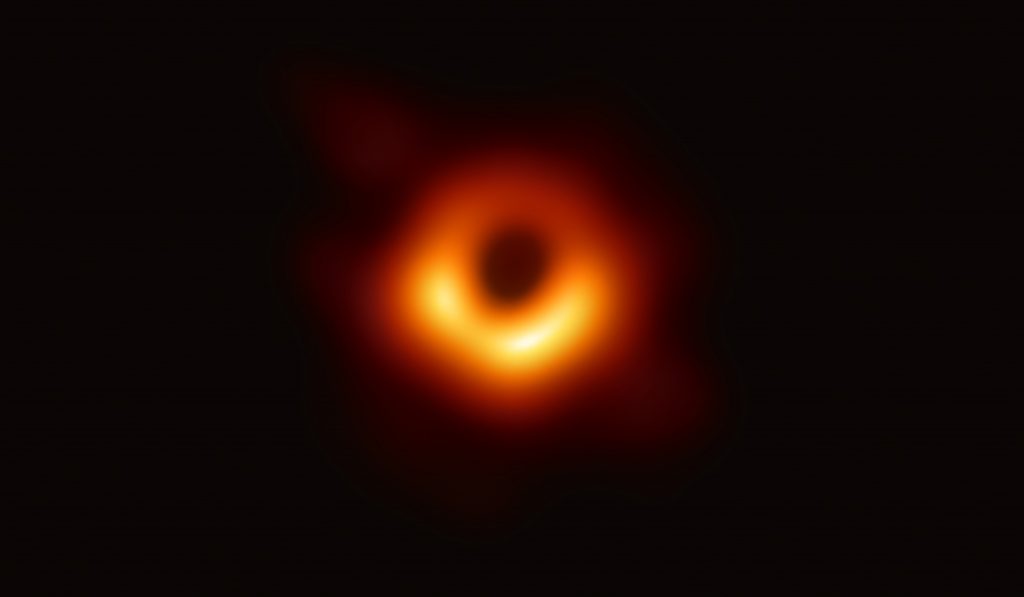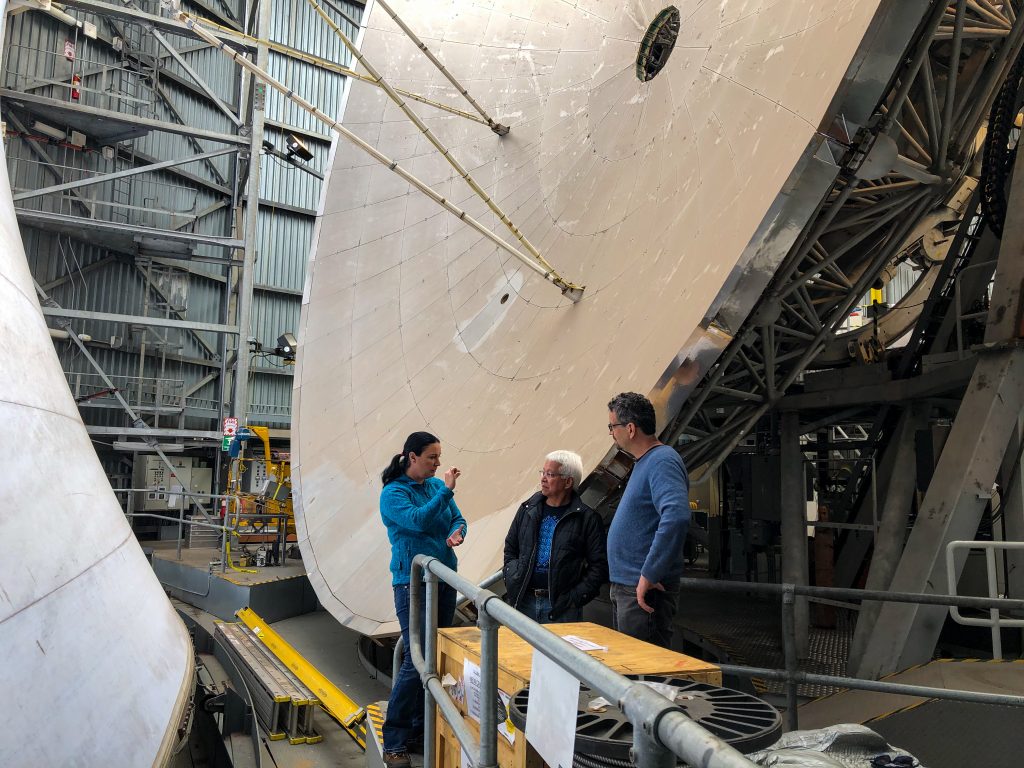MAUNAKEA, HAWAIʻI –– Two of the world’s most powerful telescopes, located atop Maunakea, played a vital role in producing the world’s very first image of a black hole. Hawai‘i-based James Clerk Maxwell Telescope (JCMT) and Submillimeter Array (SMA) are part of the unprecedented Event Horizon Telescope (EHT) project. JCMT is operated by the East Asian Observatory; SMA is operated by the Smithsonian Astrophysical Observatory and the Academia Sinica Institute of Astronomy and Astrophysics.
In April 2017, a groundbreaking observational campaign brought together eight telescopes at six locations around the globe to capture an image of Pōwehi, a supermassive black hole at the center of the Messier 87 galaxy.

Using the Event Horizon Telescope, scientists obtained an image of the black hole at the center of galaxy M87, outlined by emission from hot gas swirling around it under the influence of strong gravity near its event horizon.
“Maunakea makes this discovery and the spectacular image of Pōwehi possible,” said Dr. Jessica Dempsey, deputy director of East Asian Observatory’s James Clerk Maxwell Telescope. “It’s perfect remote position, and the dry conditions on Maunakea’s summit, allow JCMT and SMA to collect the tiny amount of light that only touches our planet in a few very special places. Like the mountain itself, every drop of light we gather is precious.”
Astronomers collaborated with renowned Hawaiian language and cultural practitioner Dr. Larry Kimura for the Hawaiian naming of the black hole. Pōwehi, meaning embellished dark source of unending creation, is a name sourced from the Kumulipo, the primordial chant describing the creation of the Hawaiian universe. Pō, profound dark source of unending creation, is a concept emphasized and repeated in the Kumulipo, while wehi, or wehiwehi, honored with embellishments, is one of many descriptions of pō in the chant.
“It is awesome that we, as Hawaiians today, are able to connect to an identity from long ago, as chanted in the 2,102 lines of the Kumulipo, and bring forward this precious inheritance for our lives today,” said Dr. Kimura, associate professor at University of Hawai‘i at Hilo Ka Haka ‘Ula o Ke‘elikolani College of Hawaiian Language. “To have the privilege of giving a Hawaiian name to the very first scientific confirmation of a black hole is very meaningful to me and my Hawaiian lineage that comes from pō, and I hope we are able to continue naming future blackholes from Hawai‘i astronomy according to the Kumulipo.”

Dr Jessica Dempsey, Dr Larry Kimura, Dr Geoff Bower discuss the results at the JCMT, in front of the 15m dish.
The SMA and JCMT telescopes are key members of the Event Horizon Telescope project, which links together strategically placed radio telescopes across the globe to form a larger, Earth-sized telescope powerful enough to see a Lehua flower petal on the moon.
“SMA and JCMT, working together as one ‘ohana, pioneered the revolutionary technique to see such tiny and faint objects and they were critical in capturing the image of Pōwehi,” said Geoff Bower, chief scientist for Hawai‘i operations of Academia Sinica Institute of Astronomy and Astrophysics. “The spirit of aloha required to unite scientists and observatories across the world was born right here on Maunakea. And powerful new capabilities coming soon at SMA and JCMT mean that Hawai‘i’s groundbreaking contributions to understanding our universe are just beginning.”
The participation of the SMA and JCMT as the far-west anchor point of EHT’s telescope array allowed astronomers to effectively observe and “photograph” supermassive black holes, among the most mysterious and powerful objects in the cosmos.
About James Clerk Maxwell Telescope
Operated by the East Asian Observatory, the James Clerk Maxwell Telescope (JCMT) is the largest astronomical telescope in the world designed specifically to operate in the submillimeter wavelength region of the spectrum. The JCMT has a diameter of 15 meters and is used to study our Solar System, interstellar and circumstellar dust and gas, and distant galaxies. It is situated near the summit of Maunakea, Hawai‘i, at an altitude of 4,092 meters.
The JCMT is operated by the East Asian Observatory on behalf of The National Astronomical Observatory of Japan; Academia Sinica Institute of Astronomy and Astrophysics, Taiwan; the Korea Astronomy and Space Science Institute; Center for Astronomical Mega-Science, China. Additional funding support is provided by the Science and Technology Facilities Council of the United Kingdom and participating universities in the United Kingdom and Canada. The East Asian Observatory also proudly partners with Vietnam, Thailand, Malaysia, Indonesia, and India. Click here for more information.
About Event Horizon Telescope
The EHT collaboration involves more than 200 researchers from Africa, Asia, Europe, North and South America. The international collaboration is working to capture the first-ever image of a black hole by creating a virtual Earth-sized telescope. Supported by considerable international investment, the EHT links existing telescopes using novel systems — creating a fundamentally new instrument with the highest angular resolving power that has yet been achieved.
The individual telescopes involved are; ALMA, APEX, the IRAM 30-meter Telescope, the IRAM NOEMA Observatory, the James Clerk Maxwell Telescope (JCMT), the Large Millimeter Telescope Alfonso Serrano (LMT), the Submillimeter Array (SMA), the Submillimeter Telescope (SMT), the South Pole Telescope (SPT), the Kitt Peak Telescope, and the Greenland Telescope (GLT).
The EHT collaboration consists of 13 stakeholder institutes; the Academia Sinica Institute of Astronomy and Astrophysics, the University of Arizona, the University of Chicago, the East Asian Observatory, Goethe-Universitaet Frankfurt, Institut de Radioastronomie Millimétrique, Large Millimeter Telescope, Max Planck Institute for Radio Astronomy, MIT Haystack Observatory, National Astronomical Observatory of Japan, Perimeter Institute for Theoretical Physics, Radboud University and the Smithsonian Astrophysical Observatory.
This research was presented in a series of six papers published today in a special issue of The Astrophysical Journal Letters.
- Paper I: The Shadow of the Supermassive Black Hole
- Paper II: Array and Instrumentation
- Paper III: Data processing and Calibration
- Paper IV: Imaging the Central Supermassive Black Hole
- Paper V: Physical Origin of the Asymmetric Ring
- Paper VI: The Shadow and Mass of the Central Black Hole
More information on the Event Horizon Telescope can be found on the EHT website. For a copy of the Press release in `ōlelo Hawai’i click here.
MEDIA CONTACT:
Dylan Beesley, Director, Bennet Group Strategic Communications
dylan at bennetgroup.com
Dr Jessica Dempsey, Deputy Director
j.dempsey at eaobservatory.org
Reactions to the news
- Representative Ed Case praised the work of Hawaii astronomers on capturing image of black hole
- Governor Ige declares April 10th – Pōwehi Day
Selection of Media
- New York Times: “That First Black Hole Seen in an Image Is Now Called Pōwehi, at Least in Hawaii”
- Big Island Video Now: Hawaii Helps See, Name Black Hole
- NPR: Introducing Pōwehi, The World-Famous Black Hole
Regional Press Releases (in local language)
Additional resources including animations



